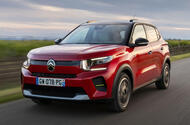Citroen will not limit petrol cars to hit electric sales mix targets


New Citroën ë-C3 aims to address customer concerns around electric car pricing
French brand wants to create “natural” demand for its EVs, rather than forcing buyers into them
Citroën has no plans to restrict sales of ICE cars in order to increase its electric car mix and will instead aim to create “natural” demand for its EVs.
Speaking to Autocar at the Paris motor show, Citroën CEO Thierry Koskas said it would be a “shame” to stop or delay sales of petrol cars in order to comply with EU fleet emission rules and the UK’s ZEV mandate.
Instead, the French brand will seek to make its EVs as usable as possible while better educating customers about the nature of owning them.
Koskas revealed that Citroën currently has an EV sales mix of just 10% in Europe – far short of the levels required by both EU and UK regulations.
However, the has been achieved with “a low offer in terms of EVs”, he said, with no electric derivative of the outgoing C3 and C5 Aircross models.
Citroën increased its European market share by 4.1% in the first half of 2024, with that growth led mainly by sales of the petrol C3, which “had an outstanding end of life”. The C4, meanwhile, is Europe’s second most popular C-segment hatchback, Koskas said.
Asked if Citroën can maintain that growth trajectory with the introduction of inevitably more expensive EVs and the retirement of the £15k C3, Koskas said simply: “We have to.”
“At the end of the day,” he said, “we want to be able to answer mobility needs while complying with the ZEV mandate in the UK and the CO2 regulations in Europe. So I need to generate a natural demand for electric vehicles.”
Uptake of EVs is stifled, Koskas says, because of customer concerns about price, range and charging infrastructure.
Citroën is tackling price concerns with the introduction of the new ë-C3, which is shortly to receive a new 124-mile variant for less than €20,000 (£17,000), and Koskas said the ranges of its larger EVs are competitive in their segments.
Concerns about charging infrastructure aren’t Citroën’s “direct responsibility”, said Koskas.
Driving EV uptake is chiefly a question of better educating customers and dealers, he opined.
“A few years ago, they were not used to selling electric cars; tomorrow they have to. But I see that things are really starting to change: they are more and more at ease selling electric cars.
“So I really think that things are moving, because we don’t want to reach a point where we would restrict the demand or production of ICE vehicles, because we’re not selling enough electric.”
With the introduction of the next-generation C5 Aircross next year, Citroën will have an electric version of each of its models, which Koskas predicts will be instrumental in boosting its EV mix.
This is particularly true for the ë-C3, for which the firm has taken some 25,000 orders already – half of the total C3 order bank.
Naturally, Koskas estimated, the other models won’t be so equally divided, but the C3 will “pull up the BEV mix, because it’s very attractive as a BEV, and that will help the overall percentage, not only for Citroen but also [its parent company] Stellantis.”
Source: Autocar RSS Feed
Recent Posts
Indiana Jones and the Great Circle’s PS5 release date will be announced tomorrow, leaker suggests
Indiana Jones and the Great Circle's PS5 release date will reportedly be announced tomorrow, 24th…
iPhone Fold leaker reaffirms 2026 launch forecasts
The iPhone Fold is once again being forecast for launch in 2026, continuing a run…
LES CLAYPOOL’S Beloved Tour Bus, “Large Marge,” Is Now On Sale
Les Claypool's affectionately named "Large Marge" is looking for a new home. The post LES…
IRS Might Soon Share Addresses of Undocumented Taxpayers with ICE
A deal between the agencies would break with longstanding taxpayer privacy laws.
ProMotion screen again rumored to spread to base iPhone 17
A new report backs up longstanding claims that the iPhone 17 will gain the ProMotion…
BMW X3 M: The Super SUV We’ll Regret Losing
The BMW X3 M has long been one of our favorite modern M Series vehicles.…